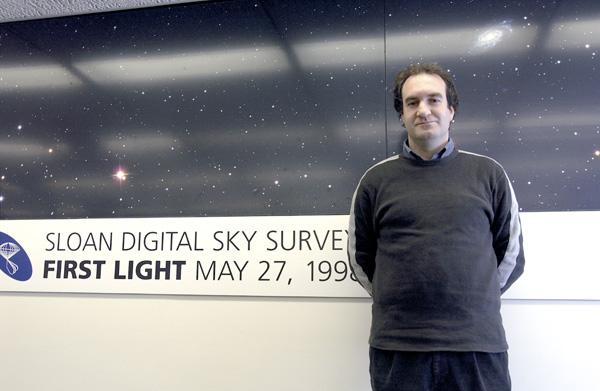 |
|
Universal Language by Gary Ruderman Many of Cristobol Lara’s students at Elgin’s Kimball Junior High School may say they feel like strangers in a strange land,as they journey into adolescence. Cristobol Lara,however, has first-hand experience in the real world, literally as a stranger in a strange land. Three years ago Lara was in the middle of teaching a physics class at a Jesuit high school in La Paz,Bolivia when his cell phone rang. The caller offered him a two-year bilingual teaching position in Elgin,Illinois. “I didn’t know where Elgin was or anything about Chicago or Illinois or U.S.education,” said Lara with a smile. English was another hurdle. He wasn’t even close to fluent. But he accepted the offer. Today,Lara has a pretty good knowledge of the Chicago area and a more fluid command of the English language. He’s completed the two years of teaching at Elgin’s Kimball Junior High and has now taken up residence at Fermilab as the Sloan Digital Sky Survey’s high school teaching fellow. Lara will use his background in mathematics and physics to prepare high school and university-level lesson plans based on the SDSS data.Fermilab is one of 12 institutions around the world making up the SDSS consortium. Lara has experienced different kinds of education away from his native Spain. After receiving masters’degrees in mathematics and physics from the University of Barcelona,Lara conducted string theory research and taught at the university and secondary level around Valencia, Spain before volunteering to teach in a lesser-developed country. “It is difficult to explain why ”he left the comfort of his homeland.“It’s something you just ‘need’to do,” he said.“I had a good job in Spain but I needed something different.” For a year, he coached basketball and taught science and computers to the indigenous Aymara community near Lake Titicaca in Bolivia.Then he was invited to teach mathematics at La Paz ’s Universidad Mayor de San Andrés in the mornings, and calculus at Catholic University in the afternoons. In the midst of this busy schedule, Lara heard about a program for bilingual teachers in the U.S.and he applied. Months later,the cell phone call came. Arriving at O’Hare International Airport in 2000 was the start of culture shock for Lara. “Often it’s a shock dealing with the cultural changes as well as being prepared for the students,” explained Doug Johnson,Lara ’s mentor and head of the bilingual education program at Kimball. “It’s a double whammy and then there ’s the need to know academic English,” which he defined as the ability to use the science vocabulary in English. “I don’t remember my first year,”said Lara. “It was all so new. I know we lived in a motel for two weeks while we got our apartments and a car and started lesson plans.” The rest is a blur. Getting a driver’s license was easy, he explained; easier than getting one in Spain. Bilingual education is a major undertaking in Elgin’s school district. It is the main way to keep foreign language-speakers at grade level while they learn English.More than 12 percent of Kimball Junior High’s 800 students take classes taught in Spanish. Lara ’s academic English teaching capabilities grew as his students ’English improved, Johnson observed.By the end of the first year, Lara was teaching one science or math course each day in English. Moving on to Fermilab last September was part of Lara ’s dream,said Johnson: “He wanted to continue in research.” Since coming to Fermilab,Lara has completed four lesson plans about black holes:the physics of redshift, emission lines,measuring distance and velocity; and one mathematics lesson plan on error analysis. The key to Lara’s lesson plans is the ability to teach a complex subject using simple mathematics. In the first plan, for example,the student is given an object’s spectra and is taught how to plot redshifts and learn velocities and distances. Students will learn astronomy the way Lara did — by studying mathematics and physics. Lara’s next move comes at the end of August when his work visa expires. It’s time to consider a Ph.D. degree, he explained, in either Spain or Mexico, and he has applied to the Spanish government for an education grant. But he is gratified by his contributions at Kimball and at Fermilab,helping strangers feel more at home. “In a lot of Mexican families that move here,the kids know no English and nothing about the area,” Lara explained.“It is very difficult.But a country is something that is living,[a place ]where people re-start their lives.A country must help [immigrants ] incorporate into society.”
ON THE WEB: |
